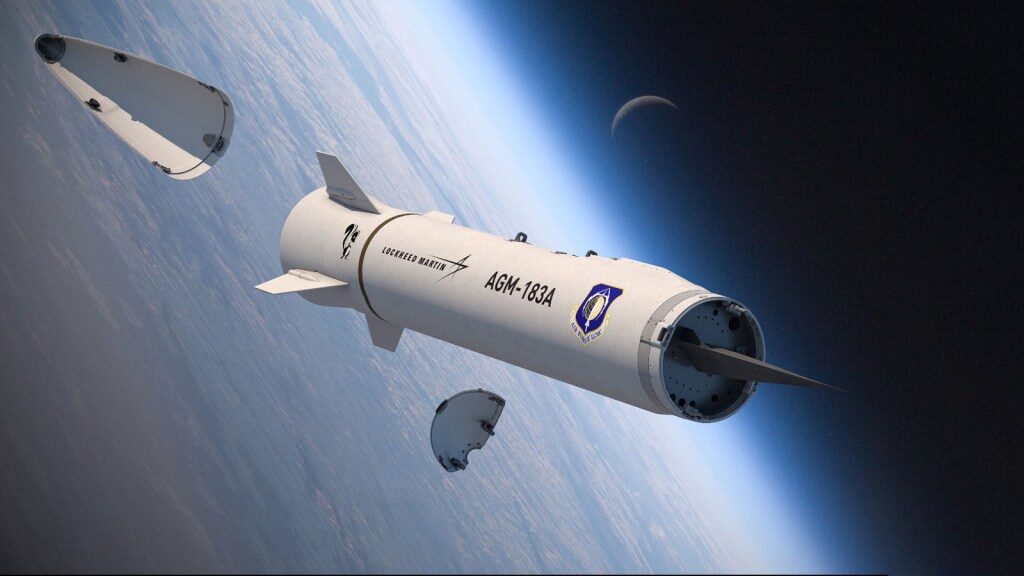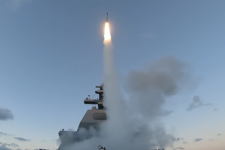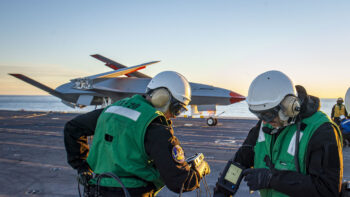
AGM-183A Air Launched Rapid Response Weapon (ARRW) hypersonic missile. (DoD)
WASHINGTON: Despite a second flight test failure, the Air Force is still pushing to begin production of the hypersonic Air Launched Rapid Response Weapon (ARRW) in fiscal 2022, Brig. Gen. Heath Collins said today.
That said, if ARRW continues to fail, the service could resuscitate the Hypersonic Conventional Strike Weapon (HCSW, pronounced hacksaw), mused Collins, who heads the Air Force Life Cycle Management Center (AFLCMC) Armaments Directorate and serves as program executive officer for weapons.
While seemingly unfazed by ARRW’s testing woes, Collins did offer that “We could go back to HCSW,” noting that the effort did complete critical design review prior to the Air Force stopping the development program last year in favor of ARRW.
“We’d have to trade that with the amount of cost and schedule that it would take to continue to pursue [ARRW] and restart HCSW,” he elaborated.
Both ARRW and HCSW are boost-glide vehicle concepts, meaning that they use a conventional rocket booster to accelerate the weapon to hypersonic speed, after which the glide body containing the warhead detaches from the booster and coasts, skipping along the upper limits of the atmosphere like a stone across a pond. Both also are Lockheed Martin products.
Collins stressed that the Air Force deliberately took on a greater modicum of risk in the rapid-prototyping effort, which is aimed at moving ARRW quickly from design to the field.
“It’s a risky program, a first-of-a-kind of missile,” he said. “We will continue to work through the root cause investigation on this failure, and continue to move forward, to get back into the test program. At this point in time, we are still postured — depending on the resolution of the failure review board — we’re still postured to … transition into production by the end of fiscal year ’22.”
The service announced on July 29 in a press release that the AGM-183A ARRW’s motor failed to ignite during a July 28 flight test.
The test nonetheless demonstrated some critical capabilities, the service’s release said: “The missile cleanly separated from the aircraft and successfully demonstrated the full release sequence including GPS acquisition, umbilical disconnect and power transfer from the aircraft to the missile. The missile also demonstrated fin operation and de-confliction maneuvers which ensures a safe operation for the aircrew.”
AFLCMC has set up a review board to figure out what exactly went wrong, which is now pouring over the testing data, Collins said, but, given that it’s only been a week since the test, it’s too early to understand the depth of the problem.
Likewise, he said, it is too soon to know whether the set back will impact the planned production schedule — and consequently, the program’s budget.
“If that is a quick and rapid resolution, then we would have minimum perturbation to our schedule, and we would look to get back in the air when our next test window is available,” he said. “If it is a little more prolonged or drives anything excessive from a redesign perspective — which we don’t know at this point — depending on how long that takes, it may impact our ability to meet our next test window as we go forward.”
The Air Force is seeking about $161 million in fiscal 2022 to produce the first 12 ARRW missiles.
However, the House Appropriations defense subcommittee earlier this month cut $44 million (four missiles) from the service’s budget request, citing concerns about the risks inherent in the plan to overlap testing and procurement (known as “concurrency,” and an issue that is a bit of a bug-a-boo for congressional overseers).
The appropriators also rebuked the Air Force for a lack of transparency and budget fluidity in the service’s hypersonic prototyping efforts funded via its research, development, test and evaluation (RTD&E) budget. To fix that, the HAC-D created new line-items for both ARRW (although they did not cut the Air Force’s $238.3 million RTD&E budget request) and the Hypersonic Attack Cruise Missile (HACM).
Lawmakers did shave $10 million from the Air Force’s request for HACM of $190.1 million, however. HACM is a highly classified program to prototype a scramjet powered, hypersonic cruise missile. A scramjet engine is “air-breathing” — taking in oxygen from the air as it flies, rather than carrying bulky oxygen tanks as do rockets. Thus HACM would be smaller, and therefore could be carried on a fighter jet — but is more technically challenging, as its parts would have to endure extremely high temperatures as it flies through the atmosphere at speeds greater than Mach 5.
Lockheed wins competition to build next-gen interceptor
The Missile Defense Agency recently accelerated plans to pick a winning vendor, a decision previously planned for next year.


























